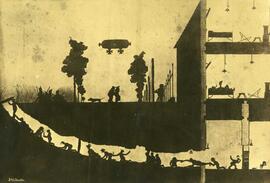HAIG, FM Douglas: copy diaries, 1914-1919
- MF856-MF865
- Collection
- 1914-1919
Microfilmed copies of the manuscript diaries of FM Douglas Haig, 1st Earl Haig, 1914-1919, and letters to his wife Dorothy Vivian Haig, Aug 1914-Mar 1919. Included in the papers are passages relating to the formation and composition of the British Expeditionary Force (BEF), under the command of FM Sir John Denton Pinkstone French, July 1914; Haig's reaction, as General Officer Commanding 1 Army, British Expeditionary Forces in France and Flanders (BEF), to the British retreat following the First Battle of Ypres, Dec 1914; plans for the British offensive at Loos, Jul-Sep 1915; correspondence with FM Horatio Herbert Kitchener, 1st Earl Kitchener of Khartoum and Broome, relating to the French's command of the Artois-Loos Offensive, Sep 1915; correspondence with Gen Sir William (Robert) Robertson, Chief of General Staff, relating to the proposed increase of British fighting forces in France, Oct 1915; the dismissal of French and the succession of Haig as Commander-in-Chief, British Armies in France, Dec 1915; Haig's recommendations for Lt Gen Sir Henry Seymour Rawlinson as his successor as General Officer Commanding 1 Army, Dec 1915; correspondence with Rt Hon Richard Burdon Haldane, 1st Viscount Haldane of Cloan, relating to Haig's appointment to Commander-in-Chief, British Armies in France, Dec 1915; orders from Kitchener to Haig concerning proposed Allied offensives in France and liaison with French Gen Joseph Jacques Cesaire Joffre, Jan 1916; letter from Robertson, Chief of the Imperial General Staff, to Haig relating to possible British offensives in the Balkans, Iraq and Germany, Jan 1916; discussions with Gen Sir Herbert Charles Onslow Plumer, General Officer Commanding 2 Army, British Armies in France, relating to possible British offensives at Ypres, Jan 1916; the German offensive at Verdun and the resultant requests by the French General Staff for a British relief offensive from Ypres to Armentières, Feb 1916; alleged incompetence within 2 Canadian Div command, Apr 1916; discussions with Robertson, Maj Gen Sir Launcelot Edward Kiggell, Chief of General Staff to British Armies in France, and Brig Gen Richard Harte Keatinge Butler, Deputy Chief of General Staff to the British Armies in France, relating to the proposed offensive at the Somme (Jul-Nov 1916), May 1916; Haig's instructions to Rawlinson, General Officer Commanding 4 Army, British Armies in France, regarding the proposed limited infantry attack on the Somme, Jun 1916; Haig's reaction to British Cabinet criticism of British casualty figures during the Somme offensive, Jul 1916; analysis of German casualty figures during the Somme offensive, Nov 1916; Haig's reaction to replacement of Rt Hon Herbert Henry Asquith, Prime Minister of Great Britain and First Lord of the Treasury, with Rt Hon David Lloyd George, 1916; Haig's reaction to replacement of Joffre as Commander-in-Chief of the French Armies with French Gen Robert Georges Nivelle, 1916; Haig's promotion to FM, 1917; supplies and manpower required for proposed British and French combined Nivelle offensive, 1917; Haig's reaction to German withdrawal to defensive positions along the Hindenburg Line, 1917; Haig's reaction to Calais Conference proceedings, in which combined British and French command council is proposed, 1917; Haig and Robertson' s veto of Gen Sir Henry Hughes Wilson as proposed British Chief of Staff liaison to Nivelle's Headquarters; the re-organisation of the Allied command structure as a result of the Calais Agreement, 1917; the failed French offensive at Aisne, Apr 1917; plans for the Passchendaele Campaign (Jul-Nov 1917) and the choice of General Hubert (de la Poer) Gough's 5 Army as the main British assaulting force, 1917; Haig's fears of a French civil and military collapse, 1917; conference with Gen John Joseph Pershing, Commander-in-Chief American Expeditionary Forces in Europe, Jul 1917; severe criticism levelled at Haig concerning his command of the Passchendaele Campaign, Jul-Nov 1917; Haig's reaction to the establishment of the Inter-Allied War Supreme War Council at Versailles, France, and the posting of Wilson as its British representative, 1918; Robertson's replacement as Chief of the Imperial General Staff by Wilson, 1918; the shortage of British military reserves in France, 1918; the failure of the German 'spring offensives' at Arras, France, Lys, Belgium, and Aisne, France, Mar-May 1918; straining relations between Haig and FM Ferdinand Foch, Marshal of France and Generalissimo of the Allied Forces, France, 1918; the Battle of Amiens, Aug 1918; the terms of the armistice, Nov 1918; perceptions of the Paris Peace Conference and the resultant Treaty of Versailles, 1919.
Haig, Douglas, 1914-1919, 1st Earl Haig, Field Marshal


